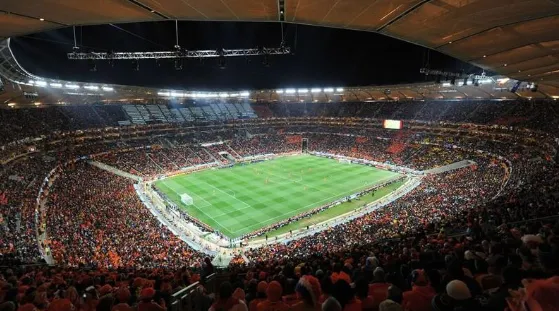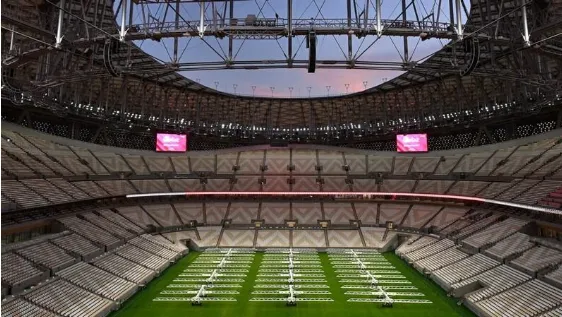FNB Stadium in Johannesburg stands as a living symbol of South Africa’s pride and passion for football. The “Calabash” rises like a giant clay bowl above Soweto, capturing the rhythm, sound, and soul of African football.
The beating core of Johannesburg’s football culture
FNB Stadium is more than a venue. It is the emotional heart of a city where football connects people of every background. The streets leading to it carry the hum of chants, drums, and endless excitement every matchday.

A landmark born from change
The stadium was redesigned for the 2010 World Cup, marking a turning point in South Africa’s sporting history. Located near Soweto, it reflects the nation’s journey from division to unity. The idea was to create a space that holds both history and hope within its walls.
The opening match of the World Cup set the tone. South Africans saw their dream unfold in front of the world, proving that African football belongs on the global stage. That pride remains strong each time the gates open again.
The people’s connection with the Calabash
The nickname “Calabash” came from its shape, modeled after traditional African pottery. It symbolizes community, food, and sharing — things that bring people together. From the outside, its orange and brown panels mimic the warm colors of the African soil.
Inside, the crowd transforms it into a living organism. Every chant, drumbeat, and flag wave turns it into a festival of culture and emotion. Fans across Vietnam can stream football live on ThapCamTV to feel that same spirit from afar.
The sounds and colors on matchdays
Matchday at FNB Stadium is a sensory storm. The vuvuzelas buzz like a swarm, the songs rise in harmony, and every goal feels like an earthquake of joy. Vendors line the streets selling flags, corn, and cold drinks. Families come early to paint faces and take pictures near the golden walls.
It’s the purest display of football energy in Africa — raw, proud, and unforgettable.
The stage of glory and unforgettable moments
The world saw FNB Stadium as the stage of legends during the 2010 FIFA World Cup. Yet, its story extends far beyond one tournament. It became a symbol of what sport can achieve in uniting people and inspiring generations.
The 2010 FIFA World Cup finale
The final between Spain and the Netherlands remains one of the most memorable nights in modern football. Over 84,000 fans filled the seats, waving flags and singing under the cold Johannesburg sky. Andrés Iniesta’s winning goal in extra time froze time itself.
That night was more than a match. It was a message of pride for an entire continent. Africa hosted the world and delivered a spectacle that will live forever.
Local rivalries and legends that shaped its story
Outside of the World Cup, local derbies keep the stadium alive. The Soweto Derby between Kaizer Chiefs and Orlando Pirates brings tens of thousands every year. It is a day of color, rivalry, and respect. The songs echo in every corner, as generations of fans pass their traditions to the next.
The stadium also welcomed football icons like Didier Drogba, Samuel Eto’o, and local hero Doctor Khumalo. Each match writes another line in its growing legend.
Beyond football – concerts and national ceremonies
FNB Stadium has also hosted moments of national reflection. It was the place where the world gathered to honor Nelson Mandela after his passing. That event showed the stadium’s deep emotional connection to South Africa’s identity.
Concerts by Beyoncé, Ed Sheeran, and local stars keep it active through every season. The venue belongs to the people — a home for every celebration, victory, and remembrance. In this setting, stories shared by football commentator Tuan Anh often highlight how such places give meaning to sport beyond the pitch.
Architecture that mirrors African identity
The design of FNB Stadium is a blend of art, culture, and technology. Its appearance and structure tell a story about Africa’s roots and ambitions. It stands as proof that tradition and modernity can coexist beautifully.

The Calabash design and its message
The outer shell was built with thousands of panels in different shades of orange and brown. At night, it glows softly like a clay pot placed over fire. This is more than design; it is symbolism. It represents warmth, gathering, and the unity that defines African life.
Capacity, comfort, and modern technology
With space for around 94,000 fans, FNB Stadium ranks among the largest in the world. The sound quality inside is sharp and powerful, designed to amplify crowd energy. The seats, lounges, and VIP areas meet international standards, yet the atmosphere remains proudly local.
A timeless symbol of hope and pride
From any angle, the stadium stands like a guardian over Johannesburg’s skyline. It represents resilience, optimism, and faith in the future. For football lovers, it’s more than concrete and steel — it’s emotion carved into architecture.
Conclusion
FNB Stadium continues to echo with chants, drums, and dreams. Every match, every concert, every cheer tells the story of a nation that found its voice through football. Its walls hold more than history; they carry the heartbeat of South Africa’s passion.